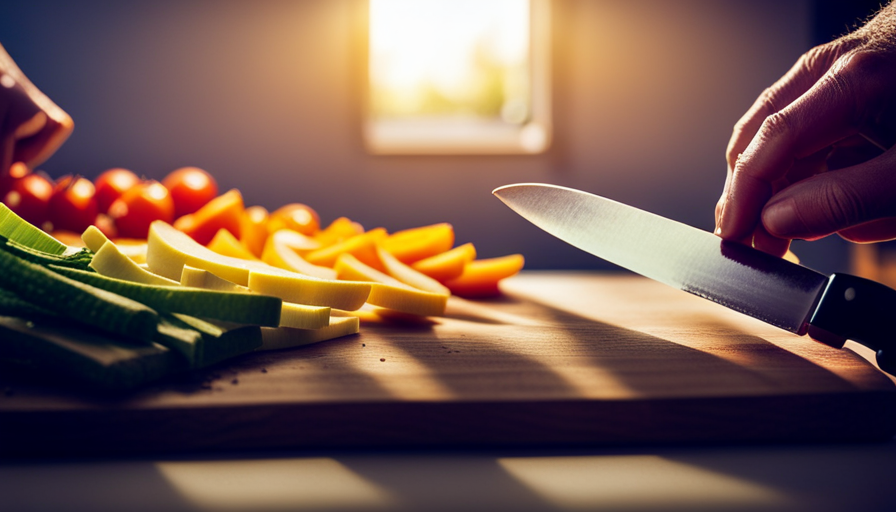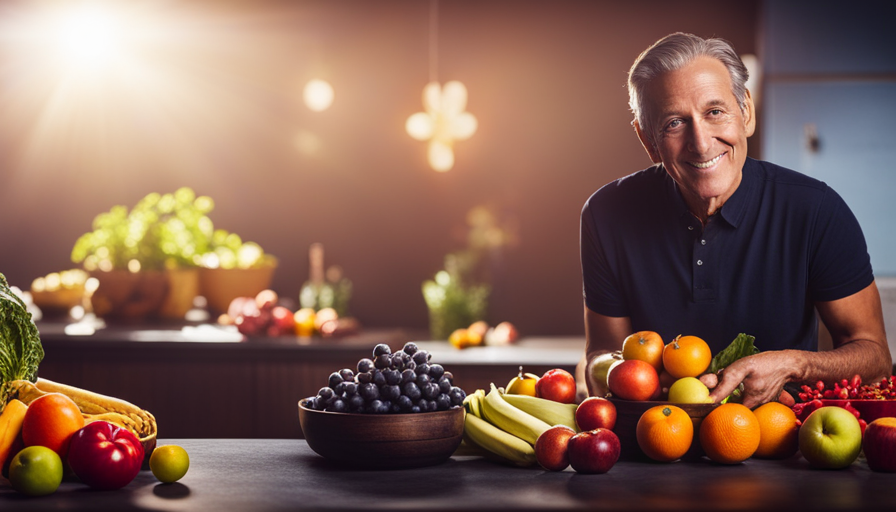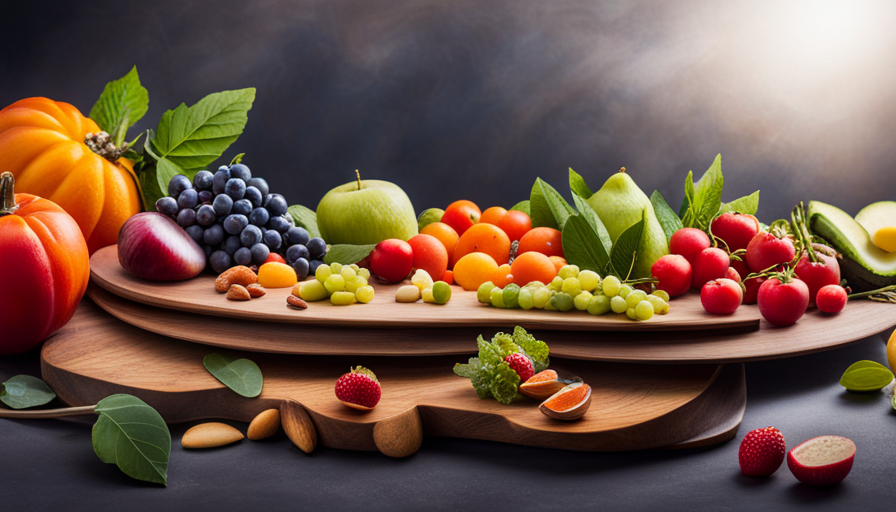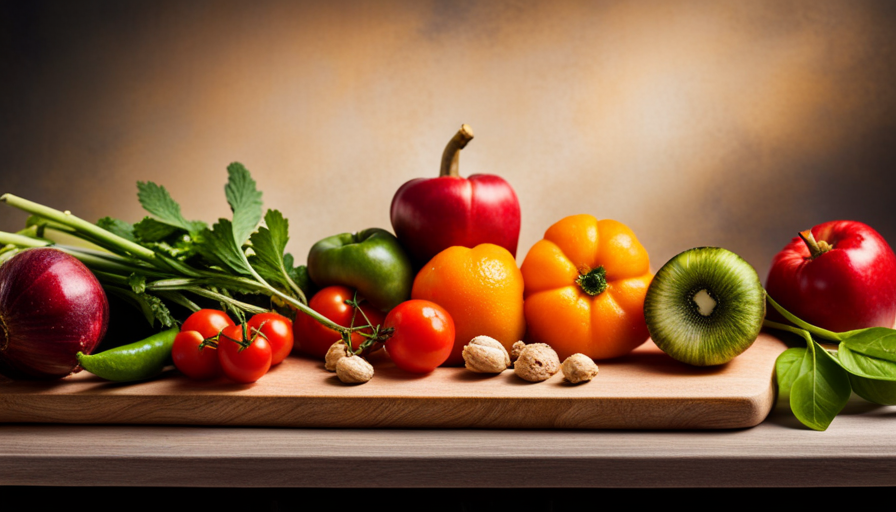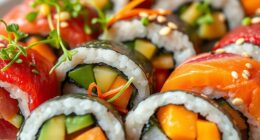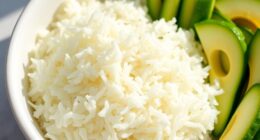Discover the exciting realm of raw food lovers, where delicious dishes are filled with flavors straight from nature to fuel your body. Like talented artists, these individuals expertly use knives, blenders, and dehydrators to turn plant-based ingredients into remarkable meals that highlight the beauty of freshness. By chopping and blending ingredients, they unleash the true essence of fruits, veggies, and nuts, offering a mouthwatering experience that revitalizes both your taste buds and spirit. Dive into this flavorful world and elevate your culinary journey with each bite you take. Uncover the magic of raw food and embrace a healthier, more vibrant lifestyle.
In this article, we delve into the realm of these dedicated individuals who prepare raw food, exploring the benefits of a raw food diet, essential tools and equipment for raw food preparation, and the art of crafting delectable raw food recipes. Discover the secrets behind successful meal planning, weight loss, and detoxification, as well as the importance of finding a supportive community.
Embark on a journey of health and vitality as you join the ranks of those who embrace the raw food lifestyle.
Key Takeaways
- Raw food enthusiasts skillfully prepare plant-based ingredients into extraordinary dishes.
- Raw food diet preserves essential nutrients and enzymes.
- Raw food is rich in antioxidants, reducing inflammation and protecting against chronic diseases.
- Transitioning to a raw food diet can have a profound impact on overall well-being.
Exploring the Raw Food Movement
If you’re curious about the Raw Food Movement, you’ll be amazed by the transformative power of uncooked, natural ingredients on your health and well-being.
Raw food restaurants have been popping up all over the world, offering a wide variety of delicious and nutritious meals made solely from raw ingredients. These restaurants cater to individuals who are looking to improve their health and embrace a more natural way of eating.
One of the key benefits of consuming raw food is the abundance of nutrients that are preserved in their natural state. Cooking food can often lead to a loss of essential vitamins, minerals, and enzymes. By opting for raw food, you ensure that your body receives all the necessary nutrients it needs to thrive.
In addition to the nutrient-rich aspect, raw food also has many other health benefits. Many people report increased energy levels, improved digestion, and weight loss after transitioning to a raw food diet. Raw food is also rich in antioxidants, which help to reduce inflammation and protect against chronic diseases.
So, if you’re looking to improve your health and well-being, consider exploring the Raw Food Movement. With its wide range of raw food restaurants and the numerous health benefits it offers, you’ll be amazed at the positive impact it can have on your life. Give it a try and experience the transformative power of uncooked, natural ingredients for yourself.
Benefits of a Raw Food Diet
Imagine the incredible advantages you’ll experience by embracing a diet filled with vibrant, uncooked nourishment. When exploring the health benefits of a raw food diet, it’s important to understand that transitioning to this lifestyle can have a profound impact on your overall well-being.
One of the key advantages is the abundance of essential nutrients and enzymes found in raw fruits, vegetables, nuts, and seeds. These nutrients are often lost during the cooking process, but when consumed raw, they provide your body with a powerful dose of vitamins, minerals, and antioxidants.
In addition to the nutrient boost, a raw food diet can also help improve digestion and increase energy levels. Raw foods are easier for the body to break down and absorb, leading to better digestion and nutrient absorption. This can help alleviate digestive issues such as bloating, gas, and constipation. Moreover, since raw foods are not processed or heated, they retain their natural energy, providing a steady source of fuel for your body throughout the day.
Furthermore, a raw food diet has been linked to weight loss and improved mental clarity. Raw foods are generally lower in calories and higher in fiber, making them a great choice for those looking to shed some extra pounds. Additionally, the abundance of nutrients in raw foods can support brain health, improving focus, concentration, and overall cognitive function.
Transitioning to a raw food diet may seem daunting at first, but with careful planning and preparation, it can be a rewarding and beneficial lifestyle choice. Start by incorporating more raw fruits, vegetables, nuts, and seeds into your meals and gradually increase your intake. Experiment with different recipes, flavors, and textures to find what works best for you. With time, you’ll begin to experience the numerous health benefits that come with embracing a diet filled with vibrant, uncooked nourishment.
Essential Tools and Equipment for Raw Food Preparation
The kitchen is equipped with all the necessary tools and equipment to effortlessly create delicious, nutrient-rich meals on a raw food diet. Whether you’re a seasoned raw food enthusiast or just starting out, having the right tools and equipment can make all the difference in your food preparation.
Here are five essential tools and equipment that every raw food chef should have in their kitchen:
-
High-speed blender: A must-have for any raw food chef, a high-speed blender can quickly and easily blend fruits, vegetables, and nuts into smoothies, soups, and sauces. Look for a blender with a powerful motor and durable blades.
-
Food dehydrator: An essential tool for creating raw food snacks like kale chips, flax crackers, and dried fruits. It removes moisture from foods while preserving their natural enzymes and nutrients.
-
Spiralizer: A handy tool for turning vegetables like zucchini and carrots into noodle-like strands. It’s perfect for creating raw pasta dishes or adding a fun twist to salads.
-
Juicer: A great tool for extracting the juice from fruits and vegetables. It allows you to enjoy the pure, concentrated nutrients of fresh produce in a convenient and delicious way.
-
Mandoline slicer: Perfect for creating thin, even slices of fruits and vegetables. It’s great for making raw food salads, vegetable chips, and decorative garnishes.
Having these essential tools and equipment in your kitchen will make raw food preparation a breeze. So, get ready to unleash your inner chef and enjoy the benefits of a raw food diet.
Incorporating a Variety of Fruits and Vegetables
Get ready to explore a vibrant world of flavors by incorporating a wide array of fruits and vegetables into your culinary creations. When it comes to raw food preparation, there is no limit to the variety of fruits and vegetables you can experiment with. By incorporating different types, you can create unique and delicious recipes that will wow your taste buds.
To give you an idea of the endless possibilities, here is a table showcasing some fruits and vegetables along with their flavor profiles:
| Fruit | Flavor Profile |
|---|---|
| Mango | Sweet and juicy |
| Avocado | Creamy and buttery |
| Pineapple | Tangy and tropical |
| Beetroot | Earthy and slightly sweet |
| Kiwi | Tart and refreshing |
Now, armed with this knowledge, you can start creating your own unique food combinations. For example, you can blend mango and avocado to make a creamy and tropical smoothie. Or, you can combine pineapple and beetroot for a tangy and colorful salad. The key is to let your creativity run wild and experiment with different flavors.
Incorporating a variety of fruits and vegetables not only adds depth and complexity to your dishes, but it also ensures you are getting a wide range of nutrients. So, don’t be afraid to step out of your comfort zone and try new combinations. Get ready to embark on a culinary adventure that will tantalize your taste buds and nourish your body.
Navigating the World of Raw Food Recipes
Embark on a mouthwatering journey as you navigate through a world of tantalizing raw recipes that’ll leave your taste buds craving for more.
When it comes to preparing raw food, there’s a vast array of recipes to choose from. From refreshing salads to hearty soups and delicious desserts, the possibilities are endless.
Exploring new flavors is one of the most exciting aspects of preparing raw food. With a focus on fresh, unprocessed ingredients, you can experiment with different combinations of fruits, vegetables, nuts, and seeds to create unique and flavorful dishes. Try adding exotic fruits like dragon fruit or jackfruit to your salads for a burst of tropical flavor, or mix up your usual smoothie routine by incorporating superfoods like maca powder or spirulina.
In addition to exploring new flavors, meal presentation techniques play a crucial role in raw food recipes. Raw food isn’t only about taste but also about visual appeal. Experiment with different ways to arrange your fruits and veggies, such as creating colorful fruit platters or arranging salad ingredients in an artistic manner. By paying attention to the presentation, you can elevate your raw dishes to a whole new level.
As you delve into the world of raw food recipes, you’ll discover a whole new way of eating that isn’t only delicious but also nourishing for your body. So, grab your apron and get ready to embark on this flavorful adventure!
Understanding the Nutritional Value of Raw Foods
Discover the abundant nutritional benefits awaiting you as you explore the world of raw cuisine, where vibrant fruits, vegetables, nuts, and seeds provide essential vitamins, minerals, and enzymes for your overall well-being.
Raw foods are packed with nutrients that are often lost through cooking, making them a fantastic addition to your diet. By consuming raw foods, you can ensure that you’re getting the maximum nutritional value from your meals.
One of the main nutritional benefits of raw foods is their high vitamin content. Fruits and vegetables are rich in vitamins such as vitamin C, which helps boost your immune system, and vitamin A, which is important for healthy vision. Nuts and seeds are also a great source of vitamins, particularly vitamin E, which is known for its antioxidant properties.
In addition to vitamins, raw foods are also abundant in minerals. These minerals play a crucial role in maintaining a healthy body, supporting functions such as bone health, nerve function, and muscle contraction. By incorporating raw foods into your diet, you can ensure that you’re getting a wide range of essential minerals.
Furthermore, raw foods contain enzymes that are necessary for digestion. Cooking foods at high temperatures can destroy these enzymes, making it harder for your body to break down and absorb nutrients. By eating raw foods, you’re providing your body with the necessary enzymes to optimize digestion and nutrient absorption.
While raw foods offer numerous nutritional benefits, it’s important to address some health concerns. Raw foods can be harder to digest for some individuals, especially those with digestive issues. It’s essential to listen to your body and make adjustments as needed. Additionally, certain raw foods, such as sprouts, may carry a higher risk of bacterial contamination. Therefore, it’s crucial to properly wash and handle these foods.
The world of raw cuisine offers a wide array of nutritional benefits. By incorporating raw fruits, vegetables, nuts, and seeds into your diet, you can provide your body with essential vitamins, minerals, and enzymes. However, it’s important to be mindful of any individual health concerns and take appropriate precautions when consuming raw foods.
Overcoming Challenges and Common Misconceptions
Now that you understand the nutritional value of raw foods, let’s address some of the challenges and common misconceptions that people who prepare raw food often face.
If you’re considering adopting a raw food diet or just incorporating more raw foods into your meals, it’s important to be aware of these obstacles and know how to overcome them.
Here are some common challenges faced by raw food enthusiasts:
-
Limited food choices: One misconception is that raw foodists have limited options. However, with creativity and knowledge, you can enjoy a wide variety of raw fruits, vegetables, nuts, seeds, and sprouts.
-
Social situations: Eating raw in social settings can be challenging, especially if others don’t understand or support your dietary choices. Educating your friends and family about the benefits of raw foods can help make these situations easier.
-
Nutritional concerns: Another misconception is that raw food diets are lacking in essential nutrients. However, with proper planning and a balanced approach, you can meet all your nutritional needs.
-
Time and preparation: Preparing raw food dishes may take more time and effort compared to traditional cooking. However, with practice and the right tools, you can streamline the process and make it more efficient.
By understanding and addressing these challenges, you can confidently navigate the world of raw food preparation and enjoy the many benefits it offers.
Tips for Successful Meal Planning and Preparation
Tackling the task of meal planning and preparation for a raw food diet can be made easier by incorporating time-saving strategies and utilizing efficient kitchen tools. Planning your meals in advance not only saves you time during the week but also ensures that you have all the necessary ingredients on hand. Start by creating a weekly meal plan, including breakfast, lunch, dinner, and snacks. This will help you stay organized and avoid last-minute scrambling.
To make the process even more efficient, consider batch cooking. Prepare large quantities of certain components, such as raw grains, nut butters, or salad dressings, and store them in the fridge for easy access throughout the week. This saves you time and makes meal assembly a breeze.
In addition to meal planning, having the right kitchen tools can greatly simplify your raw food preparation. Invest in a high-speed blender, a food processor, a mandoline slicer, and a good quality knife. These tools will make chopping, blending, and slicing a quick and effortless task.
To help you visualize the benefits of meal planning and preparation, here is a table showcasing a sample raw food meal plan for a week:
| Day | Breakfast | Lunch | Dinner | Snack |
|---|---|---|---|---|
| Monday | Green smoothie | Raw veggie wrap | Zucchini noodles | Fresh fruit |
| Tuesday | Chia pudding | Raw pad thai | Raw tacos | Raw energy bars |
| Wednesday | Acai bowl | Raw Caesar salad | Raw sushi rolls | Veggie sticks |
| Thursday | Avocado toast | Raw veggie burger | Zucchini pasta | Kale chips |
| Friday | Fruit salad | Raw pizza | Raw lasagna | Raw chocolate |
By following these meal planning and preparation tips, you can easily navigate the world of raw food and enjoy delicious, nutritious meals every day.
Raw Food for Weight Loss and Detoxification
To successfully shed pounds and cleanse your body, incorporate raw food into your diet and watch as the pounds melt away and toxins are flushed out. Raw food isn’t just delicious but also packed with nutrients that can help you achieve your weight loss goals while providing numerous health benefits.
Here are some weight loss strategies and health benefits of incorporating raw food into your diet:
-
Fill your plate with a variety of colorful fruits and vegetables. Raw fruits and vegetables are low in calories and high in fiber, which can help you feel full and satisfied while keeping your calorie intake in check.
-
Boost your metabolism with raw nuts and seeds. Nuts and seeds are rich in healthy fats and protein, which can increase your metabolism and aid in weight loss.
-
Detoxify your body with raw juices and smoothies. Freshly squeezed juices and blended smoothies are a great way to detoxify your body and get rid of harmful toxins.
-
Improve your digestion with raw fermented foods. Fermented foods like sauerkraut and kimchi are rich in probiotics, which can improve your digestion and promote a healthy gut.
Incorporating raw food into your diet can not only help you lose weight but also improve your overall health. So start enjoying the benefits of raw food today and watch as your body transforms.
Joining the Raw Food Community and Finding Support
Jump into the vibrant and vivacious world of the Raw Food Community to connect with like-minded individuals and discover the support you need to thrive on your health journey. Finding local raw food communities can be a great way to meet people who share your passion for preparing raw food. These communities often hold regular meetups, workshops, and potluck events where you can learn new recipes, exchange tips and tricks, and find inspiration. Additionally, joining online forums and social media groups dedicated to raw food can provide a virtual support network where you can ask questions, seek advice, and share your own experiences.
Transitioning to a raw food lifestyle may seem challenging at first, but with the right preparation and mindset, it can be an exciting and rewarding journey. Here are a few tips to help you make the transition smoothly:
-
Start gradually: Begin by incorporating more raw fruits, vegetables, and nuts into your diet while gradually reducing cooked and processed foods.
-
Experiment with recipes: Explore the abundance of raw food recipes available online or in raw food cookbooks. This will help you discover new flavors and prevent boredom.
-
Stock up on essentials: Make sure your pantry is well-stocked with fresh produce, nuts, seeds, and other raw food staples to make meal preparation easier.
-
Stay hydrated: Drinking plenty of water and consuming hydrating foods like cucumber and watermelon can support your body during the transition.
-
Seek support: Connect with others in the raw food community who can provide guidance, support, and motivation throughout your journey.
By finding local raw food communities and following these tips, you’ll be well on your way to thriving on a raw food lifestyle.
Frequently Asked Questions
How long does it take to see results from a raw food diet?
It typically takes some time to see the long-term effects of a raw food diet. While weight loss benefits can vary from person to person, it’s important to remember that sustainable weight loss takes time. Incorporating raw foods into your diet can lead to weight loss due to their high fiber content and low calorie density. However, results may not be immediate and consistency is key. Give your body time to adjust and be patient as you work towards your goals.
Are there any specific foods that should be avoided in a raw food diet?
When following a raw food diet, it’s important to avoid certain specific foods to ensure optimal health. Some of these foods include processed snacks, refined sugars, and oils. By eliminating these items from your diet, you can experience numerous benefits, including weight loss.
Raw foods are typically low in calories, high in fiber, and packed with nutrients, making them an excellent choice for those looking to shed pounds. So, make sure to stay away from these foods and embrace the benefits of a raw food diet for weight loss.
Can raw food recipes be adapted for individuals with dietary restrictions or allergies?
Adapting raw food recipes for individuals with dietary restrictions or allergies can be a challenge, but it’s not impossible. You may need to get creative with ingredient substitutions and modifications to ensure the recipes still meet your needs.
When it comes to children, it’s important to consider their specific nutritional requirements and taste preferences.
As for weight loss, a raw food diet can be an effective tool, as it focuses on nutrient-dense foods that are low in calories.
Is it necessary to buy organic produce for a raw food diet?
It’s not necessary to buy organic produce for a raw food diet, but it may have some benefits. Organic produce is grown without synthetic pesticides or fertilizers, which can be appealing to those concerned about their health and the environment. However, conventional produce can still be nutritious and safe to consume. It’s important to wash all fruits and vegetables thoroughly, regardless of whether they are organic or conventional, to remove any potential contaminants.
Are there any potential health risks or side effects associated with following a raw food diet?
Following a raw food diet can be like walking a tightrope without a safety net. While it may seem enticing, there are potential risks and long-term effects to consider.
Without proper precautions, you could stumble into nutrient deficiencies, bacterial infections, and digestive issues. It’s important to be meticulous in your approach, ensuring you’re getting all the necessary nutrients and properly handling and preparing your food.
So, tread carefully and stay informed to avoid any health pitfalls.
Why is it important for people who prepare raw food to wear gloves?
When preparing raw food, following fast food glove requirements is crucial to prevent contamination. Wearing gloves helps to maintain food safety by minimizing the risk of spreading bacteria and other harmful pathogens. It also protects the hands of the food preparer and ensures the cleanliness of the final product.
Conclusion
Congratulations! You’ve now reached the end of this enlightening journey into the world of raw food preparation. Hopefully, you’ve gained a newfound appreciation for the raw food movement and all its benefits.
Armed with the essential tools and equipment, you’re ready to dive into a world of vibrant fruits and vegetables. Remember, navigating the world of raw food recipes may seem daunting at first, but with a little practice, you’ll be a pro in no time. And don’t let the challenges and misconceptions discourage you – with determination and a positive mindset, you can overcome anything.
So, go ahead and start planning your raw food meals, because weight loss and detoxification await you. And if you ever need support or a sense of community, know that there are like-minded individuals out there ready to cheer you on.
Embrace the raw food lifestyle and enjoy the incredible benefits it has to offer!

